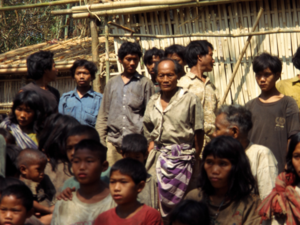- Mlabri people
-
Mlabri 
Total population ~300 (est.) Regions with significant populations Laos, Thailand Languages Mlabri, others
Religion Animism, Theravada Buddhism
The Mlabri (มลาบรี) or Mrabri are an ethnic group of Thailand and Laos, and have been called "the most interesting and least understood people in Southeast Asia"[1]. Only about 300 or fewer Mlabris remain in the world today, with some estimates as low as 100. A hill tribe in northern Thailand along the border with Laos, they have been groups of nomadic hunter-gatherers. The group in Thailand live close to the Hmong and northern Thai. The group living in Laos live close to other ethnic groups as well.
Contents
Nomenclature
The name Mlabri is a Thai/Lao alteration of the word Mrabri, which appears to come from a Khmuic term "people of the forest" – in Khmu, mra means "person" and bri "forest". They are also known locally as Phi Tong Luang (Thai: ผีตองเหลือง, Lao: ຜີຕອງເຫລືອງ) or "spirits of the yellow leaves", apparently because they abandon their shelters when the leaves begin to turn yellow.
Genetics
Genetic analysis of the Mlabri group by Hiroki Oota and colleagues led them to observe that the mtDNA has little diversity, suggesting to them that the Mlabris were founded 500–800 years ago from very few individuals. This hypothesis was contested in the journal PLoS Biology in 2005 in an exchange of articles between Hiroki Oota and colleagues, and Tony Waters.
Lifestyle
The Mlabri live an extremely primitive lifestyle. They are nomadic and have no real houses, making instead temporary shelters from palm leaves and bamboo-string. Previously they wore a loin-covering of bark or cloth, though now most Mlabri wear old factory-produced clothes procured by trade with other tribes in the area. They are hunter-gatherers, although far more of their food comes from gathering than hunting. Women give birth alone in the forest and infant mortality is very high.
They have few regimented social ceremonies, and are said to have no religious system to speak of, although it is reported that they believe in some spirits of the forest and other natural features. Marriages are concluded after simple request, with no bride-price, and the dead are buried near where they died before the tribe moves on.
Austrian anthropologist Hugo Bernatzik published an ethnography of the "Yellow Leaf People" in 1938 which reflected his brief observations of the tribe in the mid-20th century.
Bibliography
- Bernatzik, Hugo, The Spirits of the Yellow Leaves Leipzig 1938; London: R. Hale. Translated by E. W. Dickson. 1958.
- Oota, Hiroki and others, "Recent Origin and Cultural Reversion of a Hunter-Gatherer Group", PLoS biology, 2005 March, volume 3, number 3.
- Schliesinger, Joachim, Ethnic Groups of Laos, vol. 2, White Lotus 2000, pp. 187-197
- Waters, Tony, "Comment on 'Recent Origin and Cultural Reversion of a Hunter-Gatherer Group," PLoS Biology 2005 August, volume 3, number 8.
- Trier, Jesper Invoking the Spirits - fieldwork on the material and spiritual life of the Mlabri, pp. 325, 2008 July ISBN 978-87-88 415-47-6
External links
- MlaBri People - page with photographs of Mlabri people.
References
- ^ Schliesinger, Joachim, Ethnic Groups of Laos, vol. 2, ISBN 9744800364, p. 187
Ethnic groups in Thailand by language family Tai
Isan · Khorat Thai · Khün · Lanna · Lao · Lao Ga · Lao Krang · Lao Lom · Lao Loum · Lao Ngaew · Lao Song · Lao Ti · Lao Wieng · Lu · Northeastern Thai · Northern Thai · Nyaw · Nyong · Phu Thai · Phuan · Saek · Shan · Southern Thai · Tai Bueng · Tai Daeng (Red Tai) · Tai Dam (Black Tai) · Tai Gapong · Kaleun · Tai Nüa · Tai Wang · Tai Yuan · Thai (Central Thai) · YoyMalayo-Polynesian
Cham · Filipin · Male · Moken · Moklen · Pattani · Satun · Urak LawoiTibeto-Burman
Akha · Bamar · Bisu · Karen · Kayah · Lahu · Lisu · Lolo (Yi) · Mpi · Pa'o · Phrae Pwo · Phunoi · Pwo · S'gaw · UgongChinese
Chinese (general) · Han Chinese (Cantonese · Hakka · Hokkien · Teochew)Hmong-Mien
Hmong · Yao/Iu MienOther
Farang · Indians · Iranians · Japanese · Nepalis · PakistanisEthnic groups in Laos by language family Categories:- Ethnic groups in Laos
- Ethnic groups in Thailand
- Khmuic peoples
Wikimedia Foundation. 2010.
